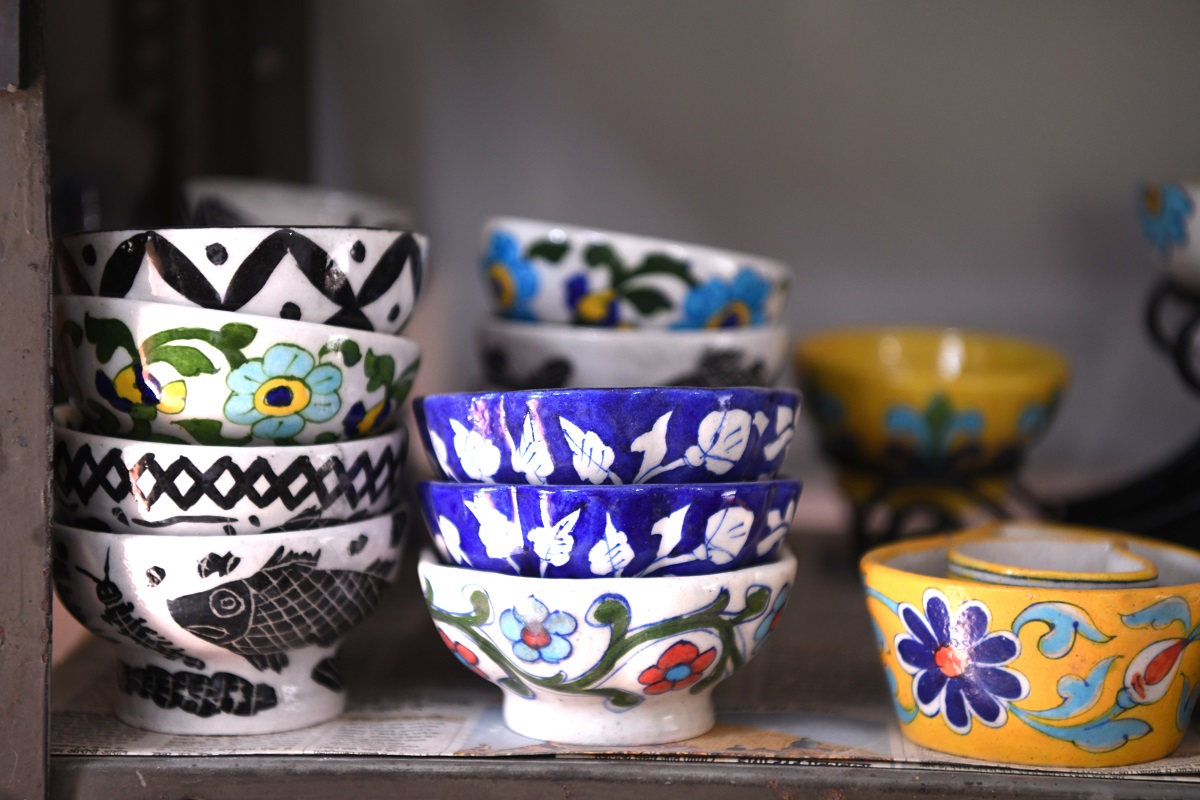Encapsulating Rajasthan’s inexhaustible repertoire of arts and crafts in one list is an impossible task. However, this list aims to introduce some of the most popular handicrafts and handlooms that are widely considered synonymous with the state.
Block Printing

While the earliest record of block-printing on fabric harks back to the Indus Valley Civilization, in Rajasthan it is believed to have flourished since medieval times and continues to be practised across the state. Sanganer, Bagru, Akola, Barmer and Pali are home to craft centres of note and have, over the years, come to be variously associated with techniques used (direct, resist, or discharge printing), colour palettes, and defining motifs (see box). A time- and labour-intensive form, traditional block-printing employs the use of eco-friendly wooden blocks and natural dyes, including indigo, to create the fetching designs that adorn saris, apparel, home linen, furnishings, and sundry other accessories.
Pottery

Clay-work is another important craft that Rajasthan’s potters have been practising for centuries. Of its most coveted forms, Jaipur’s blue pottery takes centre stage, yet it detracts little from the finely finished red-clay products of Pokhran, the unglazed kagzi (paper-thin) items that typify Alwar pottery, or the terracotta figurines of Molela, near Rajsamand. Long adept at shaping objects of daily use, toys, oil lamps, and the likenesses of deities, many dexterous artisans have kept up with the times, fashioning trendy kitchen and tableware, home accessories, and decorative planters, among others. Environmental awareness has led several potters to experiment with kilns powered by gas instead of wood.
Leather Craft

The camel-hide mojadi is perhaps Rajasthan’s most well-known leather article and can be found in raw, coloured or embroidered avatars. This sturdy handcrafted footwear is more than just a style statement, having shod the feet of farmers, herders, traders and royalty, for generations. Should souvenirs be on your mind, Jodhpur is the go-to for footwear. The city also lends its name to the famous paddock riding boot. Painted leather goods (lampshades, kupis) are a longstanding fixture of Bikaner art, while Jaisalmer specializes in ornate leather saddlery. A contemporary twist to this traditional craft has flooded retail outlets across the state with collapsible furniture, designer handbags, folders and journals, to name a few.
Handlooms
The panja durrie (named after the hand-held metal claw used to set the weft) is Rajasthan’s best conserved form of weaving. Made with homespun yarn, these reversible flat-weave floor coverings in bright hued cotton are no less than handwoven treasures. Foldable and lightweight, they are sought-after souvenirs, especially by those with an eye for ethnic designs. Hemp and jute have replaced the animal hair of yore to create a thicker, coarser type of rug. An increase in demand for mixed-yarn products has led to weavers fashioning durries from wool and jute, as well as cotton and silk. The high cost of materials has also found several artisans moving into the upcycling space, with equally attractive results. Salawas, a village near Jodhpur, hosts a large weaving community, and has emerged as a prominent centre.
Jewellery

Shaping precious metals and gemstones into wearable works of art has also been an ancient tradition of Rajasthan. Jaipur’s buzzing Johari Bazaar, for instance, is home to some of the finest handcrafted pieces of jewellery in kundan, polki, minakari, and thewa work, a near customary part of bridal ensembles today. A short walk away is the bustling Maniharon Ka Rasta, where artisans continue to practice a craft as old as the city itself: lacquer work uses a natural resin secreted by the lac insect to make brilliantly hued and glittery ornaments by hand, of which bangles are the most sought after accessory, especially during festivals like Teej and Gangaur. Other convenient-to-carry lac mementos include rings, maang-tikkas, and necklaces.
Paper-making

Another environmentally sound craft associated with Jaipur is that of paper manufacturing. The craft, in fact, predates the city. It has been practised in neighbouring Sanganer since the 16th century, when the then ruler Man Singh invited traditional papermakers called kagzis to set up shop here. Made with 100% recycled material like cotton waste, silk, and banana fibre, the handmade paper is completely wood-free. Durable and inscribable, the resulting sheets are available in a number of attractive colours, finishes, and textures, including those infused with petals and leaves. Sturdy yet beautiful, this paper is used for making notebooks, photo frames, boxes, carry bags, wrapping paper, and even collapsible display stands, all of which can be found at most manufacturing establishments across Sanganer.
Information box
Know Your Prints
● Sanganer: Muted tones on white background in dual colour, delicate floral (lotus, lily, rose, marigold, sunflower et al) and faunal motifs (deer, peacocks, and lions)
● Bagru: In shades of red, black, and cream on dyed backgrounds, with floral motifs, including whorls, circles, and other geometric patterns
● Akola: Drawn from nature, the motifs in shades of red and indigo bear defining names like kantedar, lal titri, kahma and dholika
● Barmer: Bold floral and geometric patterns in shades of red with a blue-black outline, and chirkali booti, a flaming red chilli surrounded by trees, is a common motif
● Pali: Floral motifs in soothing colours on dark backgrounds
Know Your Artisans
Click on this link to discover more about a host of artisans across the state.
Refer: industries.rajasthan.gov.in (https://industries.rajasthan.gov.in/content/industries/handmadeinrajasthandepartment.html#)




